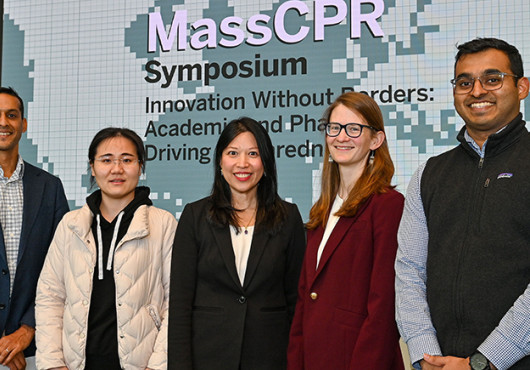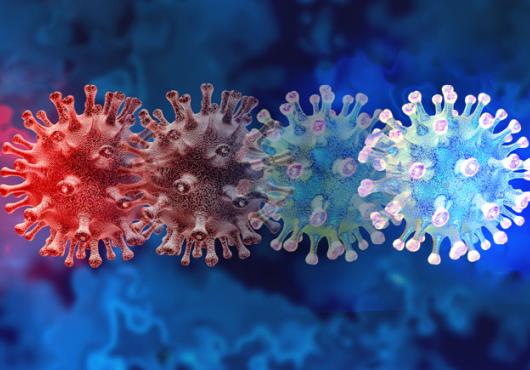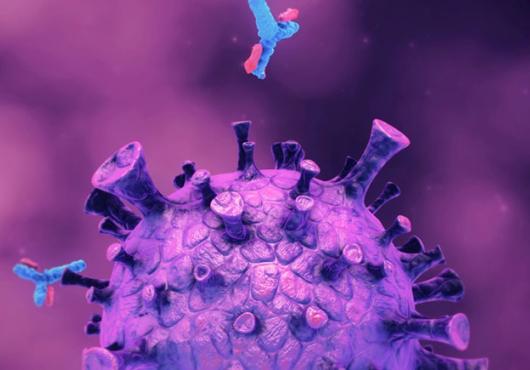This article is part of Harvard Medical School’s continuing coverage of COVID-19.
Experts from the Harvard Medical School-led Massachusetts Consortium on Pathogen Readiness, or MassCPR, this week addressed key questions about the COVID-19 pandemic. They included:
- Jacob Lemieux, HMS instructor in medicine at Mass General and co-lead of the MassCPR viral variants program
- Jeremy Luban, professor of molecular medicine, biochemistry & molecular pharmacology at UMass Chan Medical School and co-lead of the MassCPR viral variants program
- Nahid Bhadelia, co-lead of the MassCPR research group on long COVID-19; founding director, Boston University Center for Emerging Infectious Diseases Policy and Research; associate professor of infectious diseases, Boston University School of Medicine
- Zirui Song, associate professor of health care policy at Harvard Medical School; general internist at Massachusetts General Hospital
- Bruce Walker, director of the Ragon Institute of MGH, MIT and Harvard and faculty co-lead of MassCPR
Harvard Medicine News: If you were to issue a “weather report” for where things stand at this phase of the COVID-19 pandemic what would that look like?
Lemieux: Overall, the trends nationally have been very favorable in terms of cases, for almost a month now. Hospitalizations reached a peak and have been consistently trending down. I’m optimistic that deaths are also reaching a peak, but they do lag behind hospitalizations. But that peak is still really high; roughly 3,000 people are still dying every day, and that’s a tragedy. We had a new variant defined a week ago, a sublineage of BA.1 (omicron) called BA.1.1. The more striking news is the emergence of BA.2. This is the new kid on the block. It’s gone from essentially nothing to producing over one-third of cases reported globally since January 1. BA.1 and BA.2 are sister lineages, but they appear to have diverged several months prior to the current outbreak. How and when BA.2 emerged is not yet fully understood.
Two things are catching our attention about BA.2: The first is how widespread it is. It’s in dozens of countries, particularly in South Asia and Southeast Asia. It’s exponentially increased in many places and is now dominating in several locations. The most concerning thing is that the relative proportion of sequences of BA.2 has climbed relative to BA.1. It has outcompeted BA.1 in some countries. It appears to be a fitter virus that has more success transmitting in many populations. But what’s not clear is whether BA.2 is going to cause a significant number of cases and a significant burden on the health care system the way that BA.1 did. It is too early to say, but so far, it doesn’t seem to have a great effect beyond BA.1. Based on evidence from South Africa, BA.2 may contribute to the rise and the height of the peak, and may decelerate the drop-off, but it’s probably not going to radically reshape the pandemic the way BA.1 did
BA.2 is very low in New England right now, but it is likely it will increase there over time.
Luban: The sequences of BA.1 and BA.2 are very provocative. BA.1, which has been the dominant form of omicron to date, has an incredible collection of mutations, compared with the previous variants such as delta. BA.1 and BA.2 share roughly 20 mutations in the spike protein, but each one is distinguished from the other by a good nine or 10 other mutations. We know very little about many of those mutations, but they are in regions of the spike that are important for function or antibody recognition. We are just now starting to test these mutations to see what import they may have.
HM News: Pandemics seem to find the most marginalized and disenfranchised people as they spread. Has there been any progress in addressing those disparities?
Song: The simple answer is ‘no,’ as further evidence of pandemic-related disparities in outcomes has emerged. For example, in a recent study using 100 percent traditional Medicare hospitalization data, Hispanic patients and other patients in racial and ethnic minority groups admitted for COVID-19, on average, had a higher in-hospital mortality rate and 30-day mortality rate relative to white patients.
We’ve also learned that racial and ethnic minority groups face a widening disparity in outcomes beyond COVID-19 hospitalizations, likely due to the pandemic. One of the most striking examples is the widening of racial and ethnic disparities in non-COVID hospital mortality. There’s always been such a gap in mortality, but it further expanded between Black and white patients as the pandemic progressed.
Thus, where we were doing poorly in racial and ethnic disparities before the pandemic, we did even worse during, partly because of the spillover effect of COVID-19. There are a lot of potential explanations for this. On the demand side, they include which patients seek care, which patients in our society have the resources to defer care and stay home or have the resources to substitute hospital care for telehealth or at-home care. There are also supply-side factors, such as hospital decisions on whom to admit, what is the clinical threshold for admission, and does it differ for patients of different racial and ethnic backgrounds. Furthermore, there are issues of hospital capacity, and, of course, who has access to a hospital in the first place, both when you have COVID and when you don’t. These are some of the explanations on the table.
HM News: What do we know about long COVID and its relationship to variants?
Bhadelia: It has been very difficult to tease out the pathophysiology of long COVID—how and why the disease arises. Long COVID is defined as persistence of symptoms or new symptoms that present 30 days or more after the acute illness. There are several hypotheses in terms of what drives long COVID, including the sheer severity of the acute illness itself, or an inflammatory response that is different in some people, or persistence of virus in the organism. One of the most confusing things about long COVID is that people have very different presentations. Some may have more neurological symptoms—brain fog, confusion, memory loss. Others have more pulmonary symptoms, such as continued shortness of breath.
Preliminary findings have revealed some links—and I’d like to caution that these are just correlations—between long COVID and history of diabetes or the presence of autoantibodies, misfiring antibodies or friendly fire, if you will. A third observation has been the presence of acute viremia—high levels of both SARS-CoV-2 itself and the presence of Epstein-Barr virus at the same time. Another possibility is whether the virus may establish a reservoir somewhere in the body and provoke a persistent immune response. The reasons remain unclear. Regarding omicron itself, it’s been only two months since omicron came on the scene, so it’s very early from a clinical perspective to say how omicron affects long COVID. It’ll be very difficult to determine how the changes in structure of the different variants may impact the disease itself.
HM News: To what extent do vaccines modulate the risk for long COVID?
Bhadelia: A study from Israel shows that health care workers who were vaccinated had about half the rate of persistent symptoms one month after infection, compared with people who were not vaccinated. A more recent study from Israel shows that the risk of long COVID in vaccinated individuals returns to the same level as in someone who has never been infected with SARS-CoV-2. Once again, I want to caution that with such studies, the question is how is long COVID defined. One of the things we are hoping to do moving forward is to first define the clinical condition, the phenotype, and then look at the mechanisms that underlie its development.
HM News: As omicron wanes, what can schools do to transition safely back into the classroom?
Bhadelia: The off-ramp in my mind should be case rates and vaccination rates, but we have to look at local vaccination rates and transmission rates within individual communities and the trajectory of case counts—which way are they going, and not just over a day or a week but over a longer course. Also, schools that may not have good ventilation or high testing capacity may feel more vulnerable, particularly in communities where classroom sizes are much larger. There can’t be a one-size-fits-all resolution on the masks-in-schools issue. We want to see how this is playing out over a longer course than this.
Song: There has been quite striking evidence that school-age children of racial and ethnic minority backgrounds have lost more time at school during the pandemic than their peers. Schools differ in their capacity to hold classes safely, on top of differences across schools in how they approach the pandemic in general and [having the] resources to invest in masks, ventilation, or hybrid instruction. The loss in education and instruction time has not been evenly distributed and has hit disadvantaged populations quite hard—potentially further exacerbating disparities in lifetime earnings, health, and other key longer-term outcomes. Therefore, helping schools that serve disadvantaged children reopen safely, whether through physical or human resources, can be a valuable investment towards improving equity in multiple domains.
HM News: What impact do you anticipate to see from authorizing COVID-19 vaccines for children under 5 years of age?
Lemieux: In general, vaccines have had their greatest impact on preventing hospitalizations and deaths. That efficacy is preserved across variants, particularly when there’s a third dose. The vaccines have always had a substantial, but imperfect, efficacy on blocking transmission. That means that for every person you vaccinate there is an impact on that person but also on the population as a whole by reducing the propensity to transmit in the community. When an epidemic is ongoing and case counts are rising, a single infection, on average, leads to more than one secondary case.
Transmission in children is contributing to overall transmission so if we can reduce [transmission] this would be an important tool in ending the pandemic and accelerating the transition to endemicity.
For parents of children under 5, including myself, I think we’re really excited about having access to safe, effective vaccines, and the sooner such vaccines are available, the better. I am not a pediatrician, but there are severe outcomes across all age categories, and in pediatric patients there is a syndrome called MIS-C, which is an inflammatory complication that is particularly dangerous for young kids. It is something that we anticipate the vaccines would help prevent along with other complications of COVID-19.
Song: The day care labor force is an important outcome to consider in the discussion of vaccinating children under 5. The nation lost about 40 percent of day care workers at the onset of the pandemic, according to data from the Bureau of Labor Statistics. While that recovered to about 90 percent at the end of 2021, the months of October and November still saw losses between about 2,000 to 3,000 day care workers each. The increased transmissibility of omicron, resulting in additional day care closures, is likely further hindering this recovery. Therefore, vaccinating children under 5 has the potential to help day care classrooms stay open and create jobs, which is also helpful for working parents, who’d otherwise have to stay home, and thus the economy at large.






